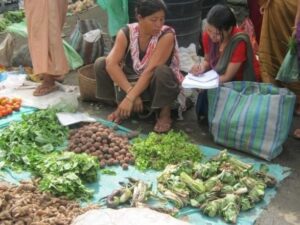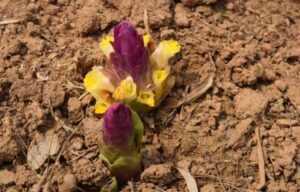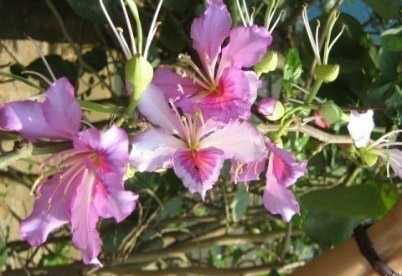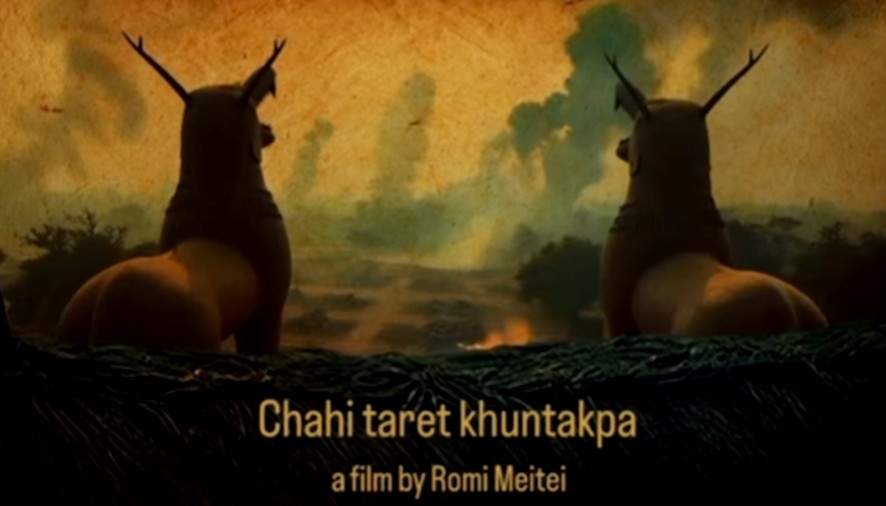‘I sold vegetables such as Yelang, Peruk, Pullei, Kengoi, Yembum Mana etc. at Lamlong Keithel, for almost one decade. But now I am not selling such vegetables anymore since last 3-4 years because it is hard to find these vegetables in the nearby hills which were grown abundantly’, expressed Wakangbam Pishakmacha of Uyumpok Mamang Leikai in Imphal East district of Manipur. Now she is working as a labourer in a nearby Koukha farm earning money only for a particular season. All those abundantly available vegetables were also very helpful for her family consumption with highly nutritional values. She opined the reason for the loss of these wild edible plants as mass cutting of trees, forest wild fires, rise of temperature, less rainfall and loss of soil fertility.
Another vegetable seller, Apee R. from Phunal Maring Village, Keirao Kendra, Imphal East also expressed that wild edible plants such as Yongchak, Peruk, Khongnang tarung, Yaipal, Loklei-Pullei, Konggouyen etc. were found plenty in the fields and hill-locks. Due to mass forest fire almost all the plants were dying. Even one of the most popular vegetables in the state –Yongchak plants are also dry or dying in the last couple of years. Now it is supplied from neigbouring state or countries.
A senior citizen, Langpoklakpam Komol (around 82 years) of Kundrakpam in Imphal East district narrated that many wild edible plants have been used as medicine since time immemorial. As for example Mukthrubi is used for treating oral diseases, Langthrei leaves for treating burning sensation in the stomach, Tairen leaves for treating skin diseases, Heibi-mana for constipation, Guava for loose motions etc. With the change of nature, many wild edible plants which were found abundantly in wild have extinct and many plants have been cultivated in the last 5-10 years.

Wild edible plants (WEPs) are the plants that grow naturally in the wild but not domesticated and can be safely consumed by humans. They have not cultivated or farmed but grow in nature on their own. These plants have historically been used by indigenous people and foragers for food, medicine and survival. WEPs have a strong connection to socio-economic aspects, especially in rural and indigenous communities. In Manipur wild edible plants are found throughout the seasons for the whole year. Indigenous knowledge about edible plants is passed down generations through oral traditions and supports cultural identity. With the changes of time, they are sold in the markets. And some which are not available in the markets are also considered as wild edible plants.
In an exclusive interview with Professor Potsangbam Kumar(retired) Department of Life Sciences, Manipur University who have done extensive research on wild edible plants expressed that according to Singh and Arora (Wild Edible Plants of India, 1978), wild edible can be classified based on the edible parts of the plants such as plants with edible leaves, plants with edible underground part, as edible flower, as edible fruits and as edible seeds and nuts. Majority of the wild edible plants are herbs with weak stem with around 60 percent and around 40 percent are shrubs, climbers and trees. Citing some examples such as Ureirom, Uuchi hangam, Chaning, Yaipal, Peruk, Monsaobi, Yelang, Yeirum Keirum, Huikhong, Konggouyen, Pheija etc. are some of the useful plants used for different purposes. He said that the present generation have less knowledge about WEPs. In Manipur, plants with the words-Yen, Ningthou, Hidak, Uthong, Lai, Ren etc. as prefix or suffix have high medicinal values. Professor Kumar stated that for a healthy diet one can take different kinds of wild edible plants available in all the seven seasons from January to December of a year. Kongouyen cooked with Chongaraba (a bird) is used for removing stone from the body. Old names of many wild edible plants have been replaced by new words as for example Perel hei has been replaced by Asi-heibong, Okchak khombi as Khongbal Takhellei, Awa Phadigom as Sha maroi etc . The fruit of Asi-heibong is used for its medicinal value for curing many diseases.

The different species of wild edible plants available in Manipur have a unique in its taste because of its soil and indigenous variety and moreover many are not available in other parts of the country and the world. As for example the taste of pods of Yongchak available in Manipur and other parts have a different taste. Professor Kumar claimed that Eshing Kambong/Lamdung Kambong of Manipur is not available at other part of the country. It is considered as an important plant in performing the rituals of Meitei Cheiroaba (Meitei New Year). Nungsham (red algae) a wild edible plants with a fishy smell found in the river attached in the stone is consumed by people after drying and cutting it in the chutney. Now, Nungsham is almost extinct in the state. Thambou (lotus stem), Heikrak (water chestnut) and Thamchet (lotus fruit) which are commonly eaten and abundantly available in Manipur is not that much popular in other places. The indigenous Heikrak species of Manipur which was found in plenty in Loktak lake is almost extinct in the wild, and more species such as Sing-ut (Singmut)/Ngareng-nga etc. are also extinct in the wild, he added.
Explaining the reason for the extinction of such wild edible plants and decreasing its population, Professor Kumar stated that according to the change of the environment and climate change, natural calamities, urbanization and settlement, extraction from the wild and human interference some of the plants which are indigenous in Manipur has already been ext

inct and some plants are very few in numbers. According to Hidaklon Puya, different wild edible plants have been recommended for different diseases. But due to the decline in the availability of wild edible and medicinal plants, many people have stop using traditional remedies. Many wild edible plants are no longer found in the wild but are now cultivated in home gardens and farms. Professor Kumar asserted that those plants which are grown in the gardens or farms are no more included in the list of wild edible plants. They become domesticated crops. In Manipur many wild edible plants which were extinct in the wild are now cultivated and domesticated because of its need and increasing price. To conserve the wild edible plants, we can follow In-situ and Ex-situ conservation, Professor Kumar added. He suggested that to regenerate these plants we can grow WEPs in controlled environment and transplant them to the wilds and restoring degraded habitats by reintroducing native edible species.
The conservation of wild edible plants is crucial for several environmental, nutritional, cultural and economic reasons. As wild edible plants are closely tied to indigenous knowledge and cultural practices, conversing them will helps preserve this heritage and ensures that traditional ecological knowledge is passed on to future generations. Modern education needs to inculcate practical knowledge about local biodiversity and ‘Ethno-Botany’ so that the younger generation will gain more knowledge about it. So, conservation is essential to prevent from extinction and thus making agriculture more sustainable protecting biodiversity, traditional knowledge, cultural heritage, medicinal value, economic potential and climate resilience.
(This article is filed under the 5th State Level Media Fellowship programme on Climate Change under the sponsorship of Directorate of Environment and Climate Change, Government of Manipur.)












